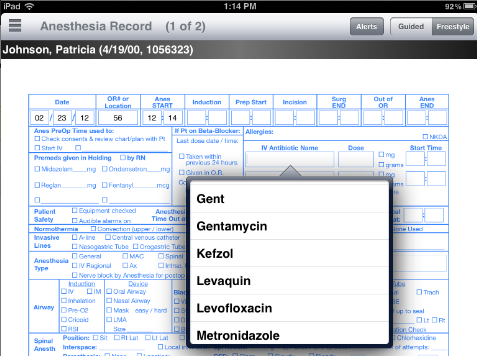Shareable Ink: the Pen and Paper EMR
There was at least one company advocating for paper records on the showroom floor at HIMSS12. But the IT twist to Shareable Ink‘s paper and pen system is that it collects and sends data to a cloud.
Physicians fill in the paper record as they normally would. Then Shareable Ink interprets natural writing — similar to the way the iPhone 4S’ Siri interprets natural language — and structures and clinically-encodes data as if had been typed on a keyboard.
“I didn’t even spell appendectomy right,” Shareable Ink CEO Stephen Hau said as he demoed the input method for me. Even if he was close, to me it looked like he had written “ap~~~dec~y.” But there it was ― “appendectomy” ― legible and spellchecked on the now electronic record displayed on the computer.
The word appeared in an orange box on the monitor, though, letting Hau know that the computer was less than 95% sure it had interpreted his handwriting correctly. A drop down menu displayed the other possible words “ap~~~dec~y” might mean. Like other natural language interpretation systems, it learns from corrections over time and grows used to physicians’ handwriting styles and abbreviations.
The inspiration for Shareable Ink came out of Hau’s past experience creating the software for PatientKeeper, a company that provides data management systems for physicians.
“We put $100 million into that company. I never went to business school. I call that my $100 million education,” Hau said.
What he learned from that $100 million education was that the industry is full of great software that people don’t want to use.
“So with that perspective, this time we said anything that changes behavior is just going to work against us. Let’s just look at what they’re doing today. And they’re mostly doing this,” Hau said, pointing to a pen and paper.
Shareable Ink takes into account the reasons why doctors are encouraged to ditch paper. Electronic medical records hold the potential for more complete and organized patient data, a more efficient way to carry out billing, and for analytics that can help to measure quality of care. With its cloud-based system, Shareable Ink allows for all of these functions and metrics, too.
Shareable Ink has been around for about three years, but its iPad application was new at HIMSS12. With the iPad app, physicians can enter items in free-style form using the keyboard, or they can toggle back to a structured view with drop down menus and check boxes.
Within provider groups, physicians can choose whatever input method they like best. Whether they use an iPad app or the Shareable Ink pen and paper, all of the data goes to the cloud.
Hau said that when the company launched the enterprise cloud offering last year, Shareable Ink was at two sites, but by the end of 2011 it had gone live at 50 hospitals.



 Idea for a guest post? Get in
Idea for a guest post? Get in